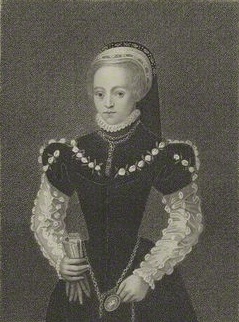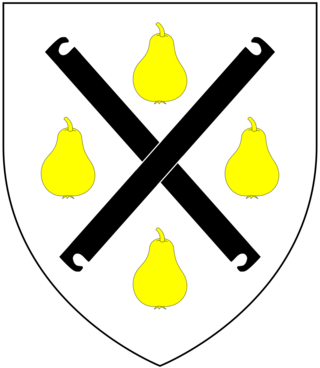Related Research Articles

John Bourchier, 2nd Baron Berners was an English soldier, statesman and translator.

Sir Henry Unton was an Elizabethan English diplomat.

Anne Seymour, Duchess of Somerset was the second wife of Edward Seymour, 1st Duke of Somerset, who held the office of Lord Protector during the first part of the reign of their nephew King Edward VI. The Duchess was briefly the most powerful woman in England. During her husband's regency she unsuccessfully claimed precedence over the queen dowager, Catherine Parr.
Sir James Harington of Exton was a 16th-century English public servant who fulfilled a number of legal, legislative and law enforcement duties and was knighted in 1565.

John Bourchier, 1st Earl of Bath was named Earl of Bath in 1536. He was feudal baron of Bampton in Devon.

John Bourchier, 2nd Earl of Bath, was an Earl in the peerage of England. He also succeeded to the titles of 12th Baron FitzWarin, Baron Daubeney and 4th Count of Eu.

Fulk Bourchier, 10th Baron FitzWarin was the son and heir of William Bourchier, 9th Baron FitzWarin (1407–1470) and the father of John Bourchier, 1st Earl of Bath. He was feudal baron of Bampton in Devon.

Sir Michael Stanhope of Shelford in Nottinghamshire, was an influential courtier who was beheaded on Tower Hill, having been convicted of conspiring to assassinate John Dudley, 1st Duke of Northumberland, and others.
Anne DudleyCountess of Warwick (1538–1588) was a writer during the sixteenth century in England, along with her sisters Lady Margaret Seymour and Lady Jane Seymour. She was the eldest daughter of Edward Seymour, 1st Duke of Somerset, who from 1547–1549 was the Lord Protector of England during the minority of her cousin, Edward VI. Being educated by the French humanist and poet, Nicholas Denisot, Anne Seymour with her sisters Margaret and Jane composed 103 Latin distichs for the tomb of Marguerite de Navarre, which were published in France as Hecatodistichon. The first edition of March 1550 was followed by a second in 1551, containing significant alterations.

John Gough Nichols (1806–1873) was an English painter and antiquary, the third generation in a family publishing business with strong connection to learned antiquarianism.
Sir Edward Unton KB was an English politician, high sheriff and Knight of the Bath.

Robert Keilway (1497–1581) of Minster Lovell Hall in Oxfordshire, was an English politician and court official.
Sir Richard Page was an English courtier. He was a gentleman of the Privy Chamber at the court of Henry VIII of England, and Vice-Chamberlain in the household of Henry VIII's illegitimate son, Henry FitzRoy. Page was imprisoned in the Tower of London in 1536 during the downfall of Anne Boleyn. He married Elizabeth Bourchier, the mother-in-law of the Protector Somerset
Edward Unton was an English landowner and MP.
Elizabeth Bourchier was an English noblewoman. She was, by her third husband, Sir Edward Stanhope, the mother of Anne Stanhope, wife of the Protector Somerset. Her fourth husband was the courtier Sir Richard Page. She died in 1557, and was buried at Clerkenwell.
Sir Richard Devereux was a rising political figure during the reign of Henry VIII and Edward VI when his career was cut short by his sudden death during the life of his father. His son would complete the family's ascendency when he was created Earl of Essex.

Sir John Eyre (1580–1639), initially of Great Chalfield Manor, Wiltshire and later of St. Giles-in-the-Fields, Middlesex was an English courtier, ambassador and Member of Parliament.
Dorothy Bulstrode or Boulstred (1592-1650) was a lady-in-waiting to Anne of Denmark. One of her older sisters was Cecily Bulstrode, who was the subject of poems by Ben Jonson and John Donne.

Anne Keilway was an English aristocrat.

Edward Cary or Carey or Carye was an English courtier and Master of the Jewel Office for Elizabeth I and James VI and I.
References
- ↑ Stanley Thomas Bindoff, House of Commons, 1509-1558, II (London, 1982), p. 506.
- ↑ John Gough Nichols, The Unton Inventories: Relating to Wadley and Faringdon (London, 1841), p. xxii.
- ↑ Arthur Collins, Proceedings, Precedents, and Arguments concerning Baronies (London, 1734), p. 342.
- ↑ John Gough Nichols, The Unton Inventories: Relating to Wadley and Faringdon (London, 1841), p. xxxiv.
- ↑ John Gough Nichols, The Unton Inventories: Relating to Wadley and Faringdon (London, 1841), p. xxxi.
- ↑ John Gough Nichols, The Unton Inventories: Relating to Wadley and Faringdon (London, 1841), p. xxxii.
- ↑ Rayne Allinson, 'Anne Keilwey Harington', Carole Levin, Anna Riehl Bertolet, Jo Eldridge Carney, eds, A Biographical Encyclopedia of Early Modern Englishwomen (Routledge, 2017), p. 67.